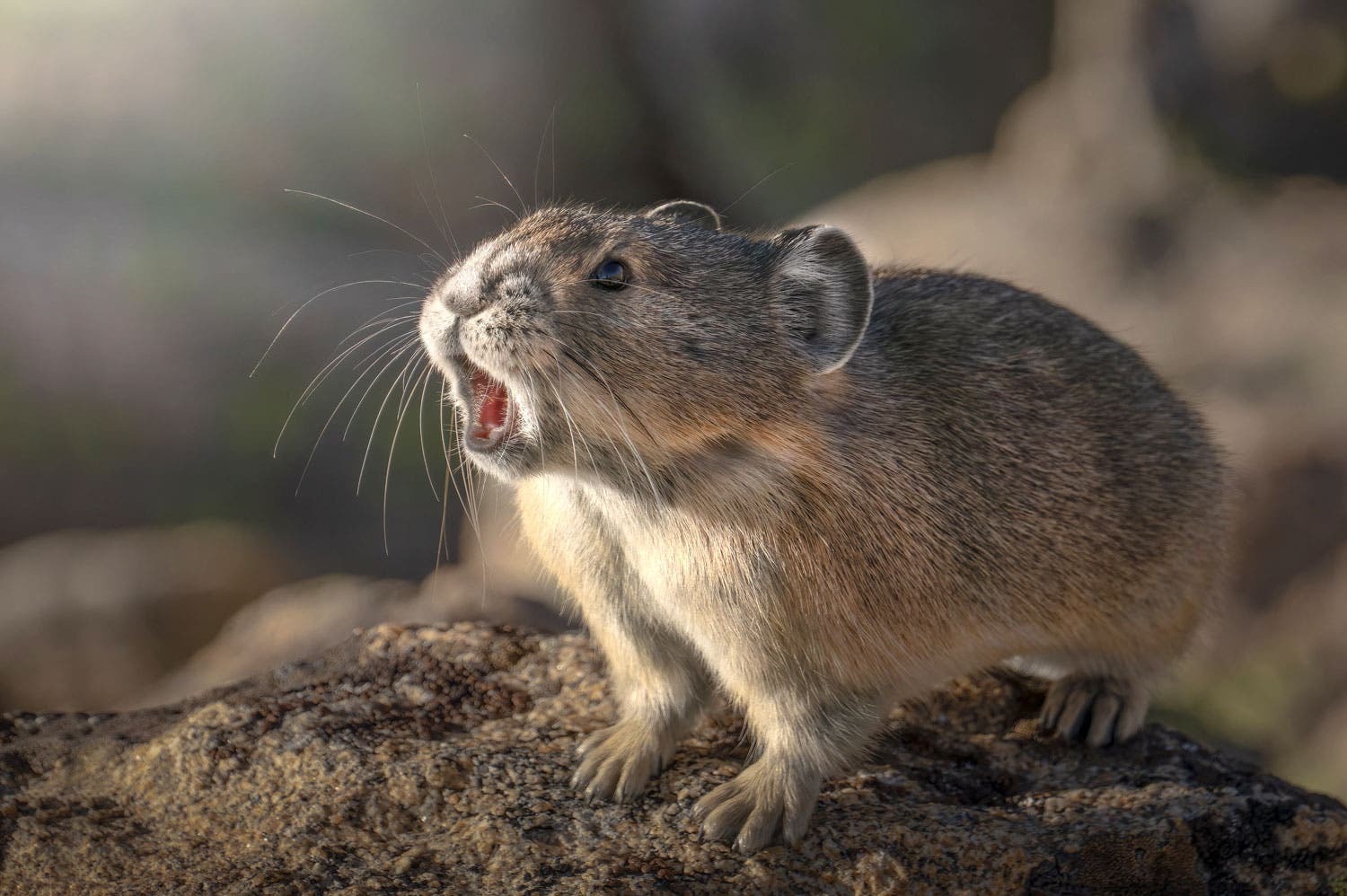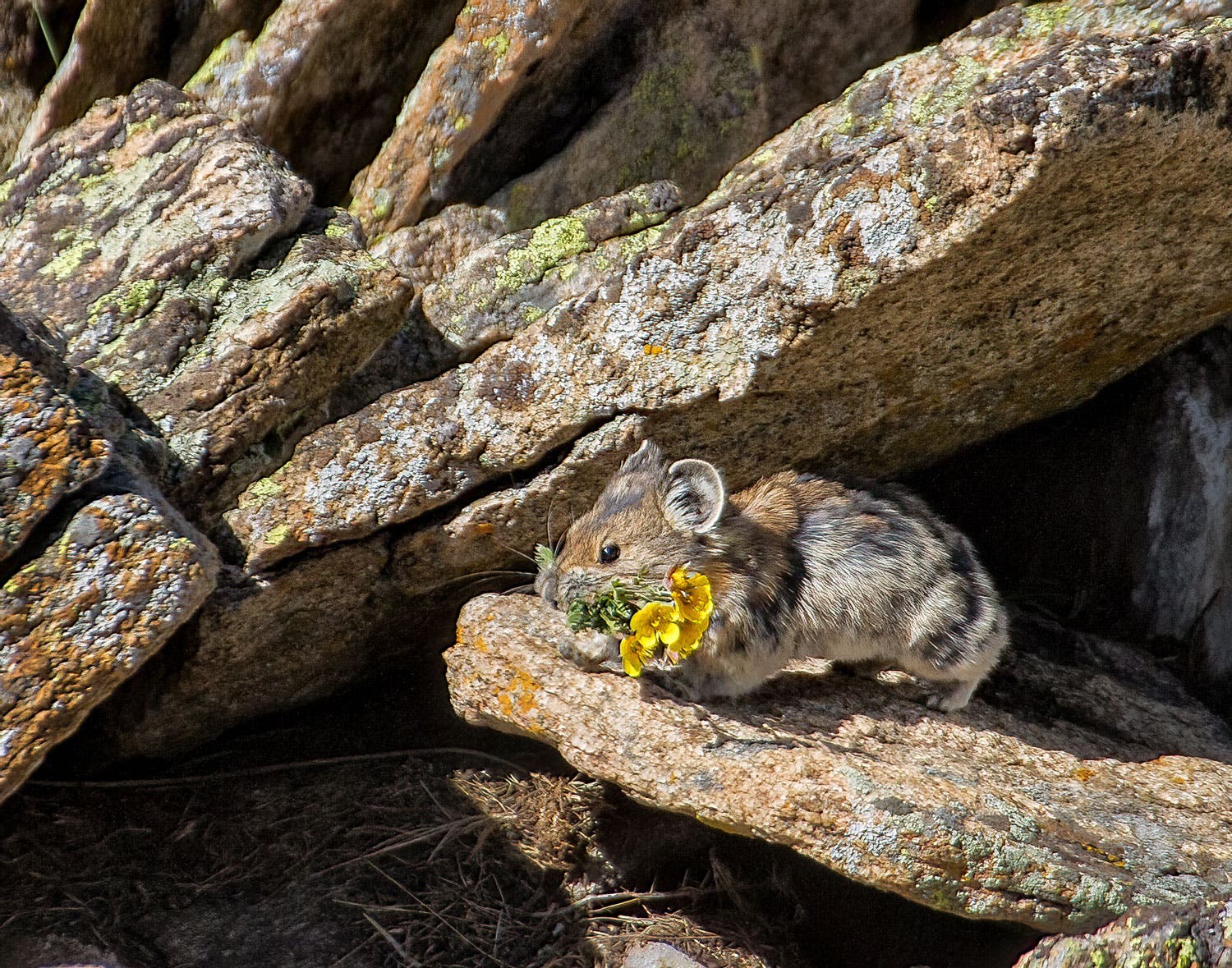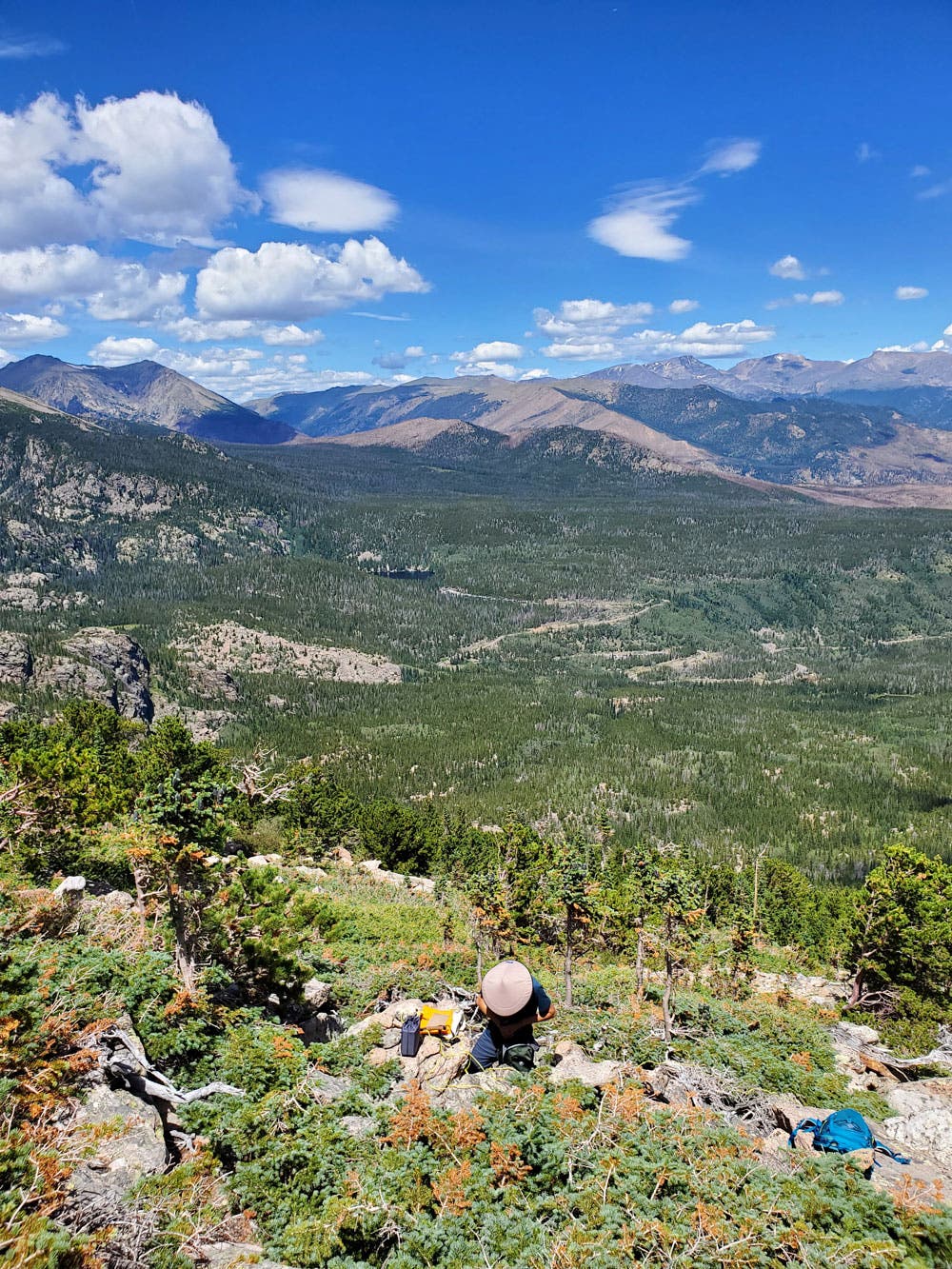Why I Climbed the Rocky Mountains to Count Pikas

Pika gathering autumn leaves to bring back to its home. (Photo: Jon LeVasseur)
“Squeeeeee!”
The shrill call sounds like someone stepped on a dog toy, but deep in the backcountry of Rocky Mountain National Park, I know better. It’s the sound of my favorite animal, a pika.
My husband and I take a break from picking our way through the undergrowth and drink from our Camelbaks. We’ve been heading straight up the side of a mountain, with no trail, for the last 45 minutes and the pika call means we’re getting close to our final destination. Somewhere in the distance, something howls, sending shivers down my spine. We check our phones again, an app called GAIA the only thing keeping us from getting hopelessly lost.
Finally, we pop out of the trees at a rock field. Called “talus” this particular type of rock results from the crumbling of larger rocks. We balance carefully as we cross the debris, testing our weight on each foot before committing to the step. Some of the bigger rocks shift precariously. In the middle of the talus, we find what we came here for. A small cairn, indicating our plot.
The view from here is mesmerizing. We’re high above most of the park. I pick out Bear Lake and the green-hued Nymph Lake, thanks to its covering of lily pads. It’s easy to tell from up here that the parking lots are all full, but it’s been hours since we’ve seen another human. We’d taken a lesser-traveled trail and followed the GPS coordinates off it some time ago, making our way up the side of a mountain in search of pikas.
These small, furry mammals had first captured my heart climbing one of Colorado’s 14ers. Mainly found in alpine talus fields, pikas (pronounced “pie-kuh”, no relation to Pikachu) are unbearably cute. I didn’t know much about them other than that they spent their time running around the mountains I often hiked, with their perfectly camouflaged coats, foraging for grasses and flowers. Sometimes, they’d sit on a rock and open their mouths wide, letting out their signature “squeeeeee!”
Then, thanks to an organization called the Colorado Pika Project (pikapartners.org), I learned that pikas are an important indicator of climate change. That did it, hook, line and sinker.

While pikas look like small rodents, something between a hamster and a guinea pig, they’re actually a member of the rabbit family. Unlike the cottontails you see in your yard, pikas have short, round, Mickey Mouse ears. They’re tiny, weighing around half a pound and measuring six to nine inches.
The barren-looking talus fields that pikas call home seem inhospitable, but these critters have perfectly evolved to live in alpine environments. They spend their summers darting around the rocks, gathering grasses, flowers and other vegetation into hay piles, which serve as their food stores for winter.
When the snow falls, it blankets the talus, insulating the crevices in the rocks to a steady 32-degrees, regardless of ambient air temperature.
“Pikas are thermally sensitive,” says Institute of Arctic and Alpine research scientist Chris Ray. “They are most comfy at 32-degrees. The talus acts as a fantastic refrigerator, keeping temperatures stable and cool in summer and winter. Even more stable than temperatures in a lab..”
Ray is one of the foremost pika experts and has been studying pikas since her undergrad days in 1988. She began by studying population dynamics. She studied pikas around the world from Montana to Mongolia to Rocky Mountain National Park. As she began to see pika populations decline, like those in the Great Basin region of Nevada, she began to wonder if the losses were related to climate change.
Pikas thrive in temperatures right around freezing, but if they get hotter than 75-degrees, they can’t survive. The talus refrigerators help keep pikas cooler than the ambient air temperature but as summers get warmer, thanks to climate change, the temperatures under the rocks will warm too.
While climate change is affecting animals and plants around the world, pikas are a unique early indicator of how alpine environments are changing because they can’t just up and move like other species might be able to as temperatures shift.

Pikas already live near the tops of their environments. Imagine a pika that lives near the top of a mountain. If temperatures get too hot for the pika to survive, it might be able to go a little higher up the mountain, but pikas are solitary creatures and territorial. If there’s already other pikas living there, they can’t just move in. There might be a taller mountain in the distance, but the pika can’t move over to that mountain without crossing low elevation regions where temperatures are even hotter. The pika is stranded on its little alpine island.
Summers aren’t pikas only problem as temperatures rise. The winters that they are so well adapted to survive are also changing. As that cozy blanket of snow becomes more unpredictable, arriving late and melting early, pikas are exposed to colder temperatures and can freeze to death. And, if a summer is particularly warm and pikas can’t leave the cool talus for enough time, they may not be able to gather enough food to get them through the winter.
“The assumption is that pikas will be hosed because of climate change,” says Ray. “But we’re studying their responses to see if there’s resiliency there.”
And that’s why my husband and I are perched on the edge of a mountain in Rocky Mountain National Park. We’re volunteering with a citizen science organization called the Colorado Pika Project, a partnership between the Denver Zoo and Rocky Mountain Wild, to help study pika habitats.
Ray and her team established 72 plot sites in Rocky Mountain National Park that have now been turned over to Colorado Pika Project to collect data from each year, along with sites across Colorado’s Front Range and White River National Forest. Long-term data from these sites will help scientists understand more about pika habitat and how it’s changing.
I’m a travel and outdoor writer and my husband’s background is in teaching English. We’re by no means scientists. My mother’s hopes of me graduating with anything other than a liberal arts degree were dashed in an unfortunate Bunsen burner/fire alarm incident in high school chemistry class. That’s the beauty of citizen science. Anyone (with a little training) can do it. It’s pretty much foolproof.
On a misty morning in July, we pulled up to a trailhead near Aspen for our official training. Our group of 20 prospective volunteers had just as varied of backgrounds as we did. There were two young guys who had just graduated high school, proudly sporting their metal band’s sweatshirts and excited to start studying environmental science in school in the fall. There was a retired couple who ran ultra-marathons and were looking for a way to more deeply explore their new Colorado home.
Together, we made our way to a talus field near the parking lot and learned how to survey an existing site. Our instructor, Denver Zoo’s community conservation coordinator, Alex Wells, told us to keep an eye out for pikas, describing them as fuzzy russet potatoes. We measured the size of the rocks, took temperatures of the air and the spaces under the talus, estimated the percentage of grasses, shrubs, trees and rocks in each site and then we went exploring. We peeked under every rock, looking for hay piles or little pyramids of pika poop to determine if there were any living in the plot.
We found both. As we sat in a circle, going over our notes, a brave pika popped out of hiding, conducting his own survey.
“Squeeeeee!” He called, showing off his little teeth to our delight.
We’d become official Pika Project volunteers after the training, sent off on our own to collect data. My husband and I had picked our site in Rocky Mountain off a spreadsheet, reasoning that a mile off trail wasn’t that far. We’d misjudged just how steep the climb would be and it’s now midday as we start our survey. The mercury in our little thermometers climbs over 80-degrees out in the open. It’s a scorching hot day for being at nearly 11,000 feet.

Despite the earlier pika call, we don’t find any signs of the critters in our plot. From the little I’d learned about pika habitat, I gather that our small plot isn’t ideal. The talus isn’t deep enough. The pika calls must have come from higher up the mountain.
We finish up our survey and begin the long trudge back down to the trailhead. As we hike, I wonder how the upslope pikas are faring on a hot day like this. Is the talus staying cool enough? What will they do when days like today increasingly became the norm?
Maybe it’s the hanger talking (I’d run out of snacks several hours ago thanks to our longer-than-anticipated adventure) but I can’t help feeling a bit despondent on the future of alpine environments like Rocky Mountain National Park. A 2015 report in the journal Nature Climate Change suggested that our mountains are warming faster than lower-elevation areas. If this is indeed the case, the park will see even more rapid effects from climate change than my home outside of Denver will.
Other than being my favorite place to recreate, mountains are also a source of fresh water, Ray reminded me when we spoke.
Because talus fields act like refrigerators, they hold on to ice under the rocks, which is an important source of freshwater for humans.
“As we face glacier and surface ice loss, the talus fields become the last best place for ice,” says Ray. “Pikas can also act as an indicator for water research.”
That evening, after washing off the sweat and staving off dying of starvation, we log onto the portal to submit our survey data and sign up for our next mission. My sense of despondency begins to fade.
Nearly every single site has volunteers signed up for surveys.
“Pikas habitat may be beautiful, but the alpine is not always easy to access,” says Wells. “Without the help of community scientists, we’d never be able to monitor almost 200 backcountry research sites, and it’s this detailed, landscape-scale dataset that is critical to digging into the state of pikas in the Southern Rocky Mountains. Not to mention that being a community science project allows us to raise more awareness about the impacts of climate change on our wildlife and ecosystems.”
It’s easy to feel helpless when faced with a seemingly insurmountable issue like climate change, but I was reminded as we scrolled through the spreadsheet, looking for an open site to survey, that we can make a difference. Every single one of these volunteers was spending their weekends, their summer breaks or their retirements providing crucial data to help scientists study climate change. It’s one thing to post on social media, to vote, to talk about it with friends at the brewery. It’s another thing to climb a mountain for it.
The winters might be getting shorter, the temperatures might be rising and both pika habitat and drinking water might be disappearing, but for the first time in a while, I began to feel hopeful, for the pikas and for the future of humanity.
I was doing something to help, and I was not alone.
If you need a dose of hope in your life, get involved in citizen science on your next trip to Colorado. Download the Pika Patrol app (pikapartners.org/pikapatrol/) in Google Play or the Apple App Store to report your pika sightings and contribute data to habitat research.